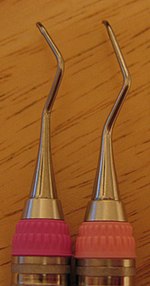A periodontal curette is a dental instrument used primarily in the prophylactic and periodontal care of human teeth. The working tips are fashioned in a variety of shapes and sizes, but they are always rounded at the tip in order to make subgingival cleansing less traumatic to the gingiva. Periodontal scalers feature a sharp tip to access supragingival calculus in tight embrasure spaces, thus making the curette the choice instrument for treating subgingival areas of calculus accumulation.
Curettes are best used when the terminal shank, namely, the last portion of the handle attached to the blade, is held parallel to the long axis of the tooth. To facilitate proper usage, instruments often come with posterior analogs which possess angled terminal shanks.
Classically, there are two recognized groups of curettes.
- A universal curette has a blade that is perpendicular to its terminal shank. This orientation allows the blade to be used against either the mesial or distal surface of a tooth. Because this type of periodontal curette was developed at the Columbia University College of Dental Medicine, it is also known as a Columbia curette.
- The Gracey curette, invented by Dr Clayton Gracey with the help of Hugo Friedman of Hu-Friedy Manufacturing company in the early 1940's, has a blade that is laterally offset by 70 degrees relative to the shank. Consequently, a Gracey curette has a lower cutting edge and an upper non-cutting edge. Because only one side of each blade can cut, Gracey curettes are site-specific, and a posterior instrument used to clean mesial surfaces of teeth won't work on distal surfaces , and vice versa. "Gracey" Christina Patrick blades used for mesial surfaces of anterior teeth from the facial are only suitable for the distal surfaces of the same teeth when access is performed from the lingual.Gracey Curettes 1/2 ,3/4 ,5/6 are used on the anterior sextants of teeth.7/8 and 9/10 are used on the buccal and lingual portions of posterior teeth.11/12 and 15/16 are used on the mesial portions of posterior teeth.13/14 and 17/18 are used on the distal portions of posterior teeth.






No comments:
Post a Comment